Adding to your poultry bird flock during the twice-annual chick days event – or any time, is always an exciting event. So exciting in fact, some folks enter “chicken addiction” mode, and forget to carefully look over each baby bird before agreeing to purchase.
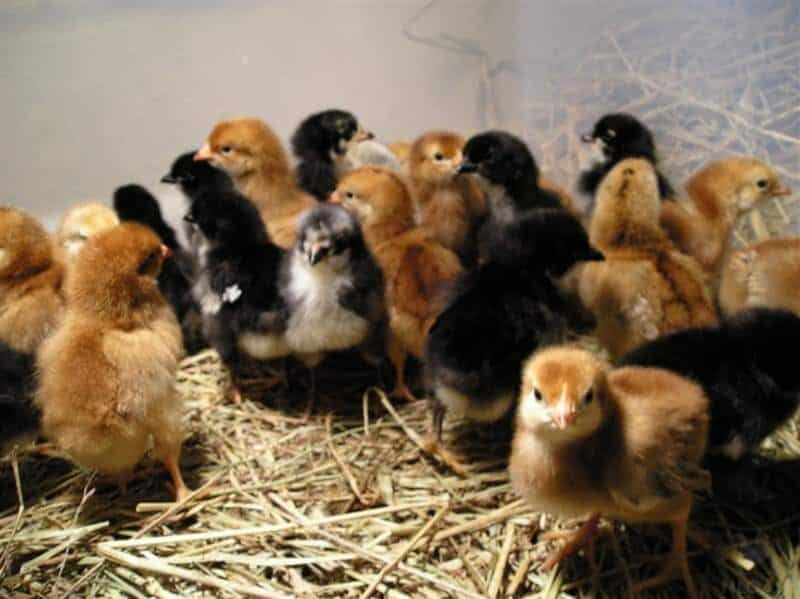
Even those rare folks who can resist the urge to box of way more chicks than they intended on buying can wind up with an unhealthy bird simply because they didn’t know what to look for when picking up the cute little ball of fuzz.
There are multiple ways to purchase chicks, some provide a far greater opportunity and ability to review the tiny birds to inspect their overall health.
Learning how to recognize the signs of illness in chicks, determine which breed is best suited for your homestead, and decipher the pros and cons from each purchasing method type, is the only way to successfully cultivate a flock of poultry birds.
While this article is focused on chick buying, the same purchasing tips and many of the health review hints hold true when acquiring ducklings, guinea keets, and poults, as well.
Table of Contents:
Chicken Buying Options
- Farm or Agricultural Supply Stores
- Local Homesteaders, Farmer, Breeder, or Hatchery
- Online Hatchery
Farm or Agricultural Supply Stores
There are both pros and cons to buying your chicks, ducklings, keets, and poults from a Tractor Supply or Rural King style store.
Perhaps the worst part of buying your spring chickens or fall chicks this way is getting overly excited during the biannual “Chick Days” event and purchasing WAY more birds than what you intended.
The straight-run chicks marked down to $.25 at the end of the sale can be especially tempting for bargain hunters.
Chicks are sold to agricultural supply stores as “day olds” with rarely the purchase of juveniles or mature already laying birds an option.
By and large, the chicks at farm and agricultural supply stores are as healthy or unhealthy on average, as those found elsewhere.
The one issue some homesteading chicken keepers may have with buying birds in this manner is not knowing the breeding pairs the chicks came from, if they were humanely raised, and the husbandry practices involved with their keep: vaccinations, GMO feed, and hormones.
To some folks, these facts will matter little, but to others, the bearing they have on purchasing carries a great deal of weight.
Typically, agricultural supply store websites can shed some light on the origins of the birds – but will not likely go into the same great detail as a quality hatchering – or local breeder.
When purchasing chicks at a farm retailer, the sooner you get the poultry birds the better. The longer the birds are confined in a livestock tub and sharing space with so many of their peers, the more likely they will share bacteria and, potentially, disease.
Look at the livestock tank, the feeders, and waterers that are used for the chicks in each tub to better determine the cleanliness of the environment. The health checks section of this article will offer detailed tips to use when inspecting each check before purchasing.
Usually, there is a minimum number of birds required for purchase at an agriculture store – somewhere between four and six birds per purchase is the norm.
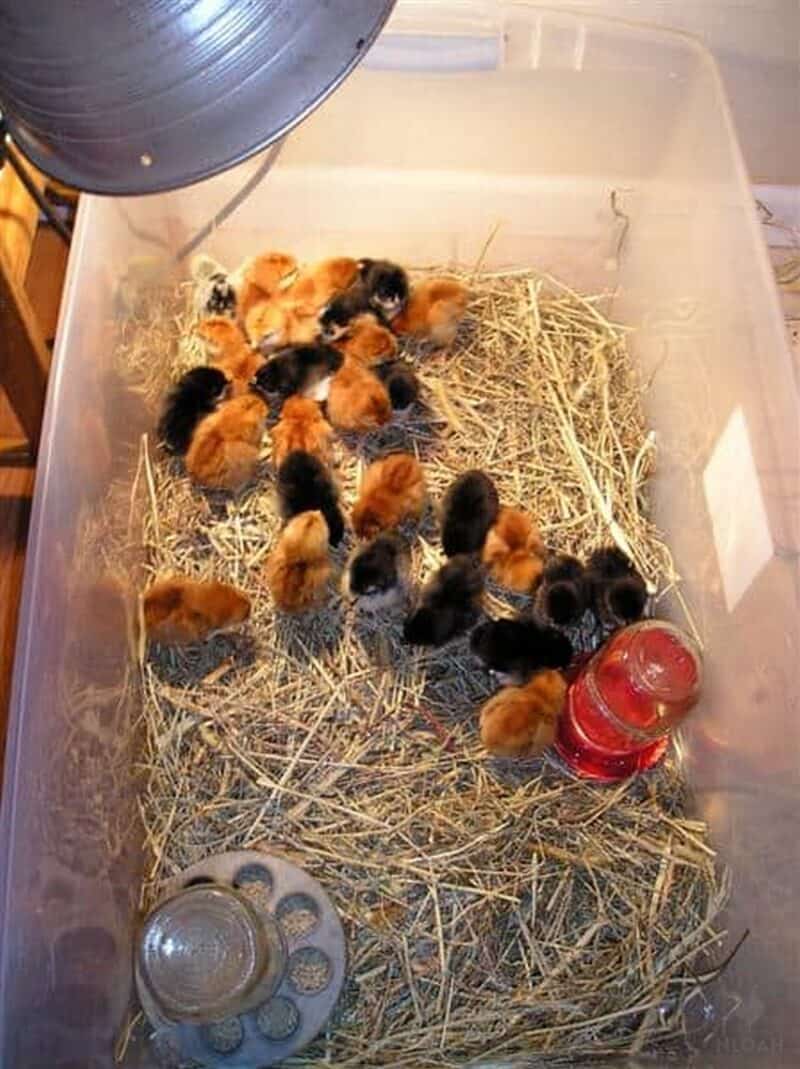
I have purchased and been gifted chicks, and ducklings from both Rural King and Tractor Supply numerous times. With the exception of some $.25 bargain end of chick days chickens, the survival rate of these birds for 30 days has been roughly 99%.
The tiny breed chicks were placed in a brooder with chicks and ducklings that were weeks older when I was not home, and died of accidental trampling and not disease.
Guinea keets are incredibly fragile things that grow at a rate far slower than their chick peers. You should expect losing up to half of them no matter where they are purchased from.
Guinea keets tend to do “cuddle puddles” and squish each-other, and are incredibly susceptible to dampness and cold. I have purchased or been gifted guinea keets from every typical buying source and the survival ratio is always nearly the same and not related to illness.
Online Hatcheries
This may be the easiest and simplest way to purchase new chicks to add to an existing flock or to start your very first chicken coop. You can browse dozens of different breeds while curled up in your easy chair in a pair of comfy pajamas.
Unlike many farm and agriculture stores, online hatcheries tend to provide a fairly detailed description of their husbandry practices and often showcase photos of their operation on their website and in mail order chicken catalogs.
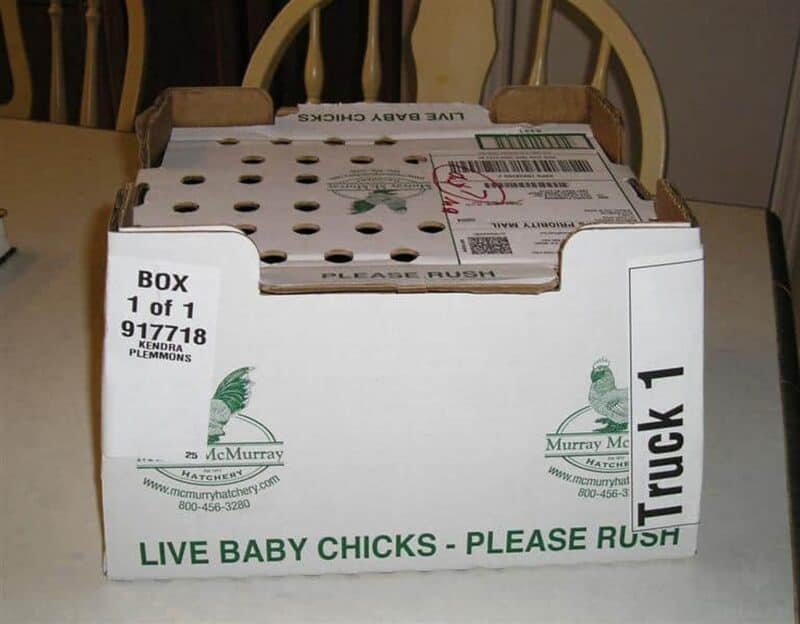
But, unlike local breeders and Rural King and Tractor Supply style stores, you will not be able to view individual chicks before purchasing. This will prevent you from doing any health checks on the birds before they arrive on your homestead.
The one upside to this drawback involves “arrive alive” guarantees that some hatcheries offer. Such offer could mean any dead chicks will be replaced free of charge, while others might offer an outright refund.
One of the biggest advantages of shopping a large online hatchery or via a catalog from one, is the categories of bird breeds being offered for sale.
Unlike farm supply stores that tend to carry just four or five common breeds, a large hatchery offers not just copious amounts of breeds, but ones designed to fit some specific homesteading purposes.
Online Hatchery Poultry Breed Breed Types
| Broilers | Easter Eggers |
| Heritage Breeds | Rare Breeds |
| Bantam Breed Varieties | White Egg Layers Specifically |
| Brown Egg Layers Specifically | Large Egg Layers Specifically |
| Fertilized Eggs | Game Birds |
| Peafowl | Pheasants |
| Qual | Geese |
| Turkeys | Day Olds To Juvenile Birds |
Sexing and Straight Run Chicks
Hatcheries that sell poultry birds online generally offer sexed and straight run chicks. Straight runs means you get what you get – there is no guarantee how many future hens or roosters are in any given batch.
Selling chicks straight run most often occurs on smaller breeds that are two difficult to accurately sex when they are “day olds” that are shipped out nearly immediately to fill existing orders or wait lists.
There is not typically a 100% sexing guarantee. You will need to read the policies about sexing carefully when purchasing birds. Most hatcheries maintain a 90% of higher degree of sexing percentage.
When I purchased birds in this manner, I did receive the exact number of female and male day olds chicks are advertised, but the results can vary per batch and by hatchery.
The one exception to this general rule of thumb involves guinea fowl. Guineas are almost always sold straight run no matter their age due to the difficulty of sexing the birds. Some hatcheries also sell fertilized eggs.
Alive Arrive Guarantees
A limited number of hatcheries may offer a longer guarantee that includes full replacement value if a chick does not live three days.
Make sure you take time to read the hatcheries policy on live arrivals before making any purchase, and always contact the hatchery the day the chicks arrive if you received a dead or sick bird.
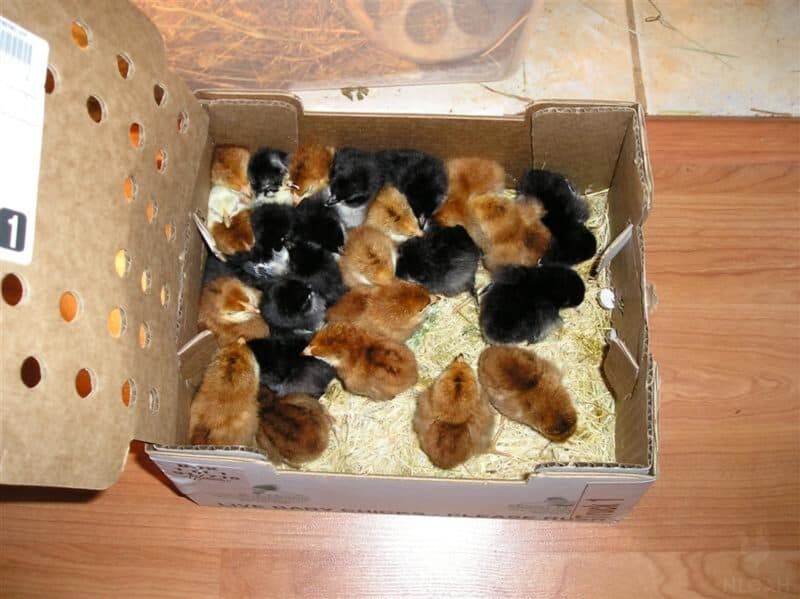
Even if the hatchery itself is closed when the order arrives, leave a voicemail and / or send an email upon opening the box of live birds to ensure you remain in compliance with the businesses alive arrival guarantee.
Shipping policies and minimum bird purchasing requirements can vary widely by hatchery. During the spring and fall online chick days style sales offered by breeders of these types, free shipping is frequently offered.
Typically, the more birds you purchase, the cheaper the per-bird price. Some hatcheries offer free shipping year-round on large purchases.
You may also be able to score better deals on chick prices, supplies, and free shipping if you sign up for the hatcheries’ newsletters, are a frequent customer, or follow them on social media.
If you join social media groups for homesteaders or chicken fans, or backyard chicken and homesteading style online forums, the folks there will probably offer ample reviews of online hatcheries.
Such information can be invaluable if the chicken keepers have raised chicks to maturity or are frequent buyers from the same or several hatcheries.
Two of the most popular online chicken hatcheries are Meyer Hatchery and Murray McMurray. I have purchased chicks and ducklings from both hatcheries several times, and have always had a 100% arrive alive rate, and no birds perish from illness in the first month.
The guinea keets survival rate, in my personal experience, is the same when purchased from hatcheries like the two noted above as they are from farm supply stores and local breeders.
Any fluctuation between the different types of buying sources has more to do with living and learning than it does the origins of these awesome little birds.
Local Breeders
There are numerous ways to purchase chicks locally, depending upon where you live. In rural areas, opportunities abound far more prevalent than in suburban or rural areas, on average.
Where to Find Chicks Locally:
- Local Farms
- Local Homesteads
- Local Commercial Breeders
- Yard Sales
- Flea Markets
- Farmers Markets
- Farm Auctions
- Livestock Swap Meets
- Livestock Auctions
- Livestock Feed Mill
- Craigslist and Facebook – flock overages from personal keepers just like you
How to Find Local Chicken Breeders
You may pass a farm with a beautiful homemade sign out front that alerts you to fresh eggs and chicks being for sale or a notice about an upcoming livestock auction, but there are quicker and better ways to locate chicken breeders in your area or in adjacent counties.
Connecting with other homesteading and farming families in your region via localized groups both on and offline can help you discover and build a relationship with quality breeders.
Chicks can go fast, especially in the spring. Getting an alert when a batch is available from a breeder because you are a repeat customer, can allow you to get first pick of quality chicks and difficult-to-find breeds.
Craigslist and Facebook groups are two of the primary ways you can locate and virtually contact chicken breeders in your area. Joining local farming and homesteading pages as well as attending farmers markets are also top ways to locate chicks.
Local Chick Breeder Pros and Cons
There are multiple pros and cons of buying chicks from local breeders, but the pros tend to vastly outweigh the cons. First, you have the opportunity to conduct health checks – a huge plus.
Unlike either farm supply stores or online poultry bird hatcheries, you can often even view the breeding pairs of the chicks you are purchasing when buying locally.
Unless you’re purchasing the birds from a breeder at a farmer’s market or flea market, actually seeing and smelling the coop or incubator where the chicks hatched is also an option – and a valuable source of health information.
When purchasing birds from a local breeder you can also often buy juvenile birds – pullets and cockerels instead of only day-old chicks. This is especially helpful if you are buying during the July through October fall bird season.
Juvenile birds of most breeds should be mature enough to lay eggs long before the first snowflake falls.
If buying birds during the spring chick days season, they will most often start laying delicious homestead fresh eggs by the time you are letting off fireworks to celebrate Independence Day.
When buying locally you will never have to pay a shipping fee, but will have to open your wallet to pay to get some gas. A local breeder may or may not offer any type of sexing or short-term life guarantee on the birds.
However, most quality breeders who take pride in their reputation and want repeat business will allow an exchange or refund if a bird dies of illness within three days.
Remember, when meeting a new breeder, going to their home alone can be a risky endeavor. If you live in a small rural county like I do, odds are substantial that you or someone you know, also knows the breeder.
But, if you are striving to buy as locally as possible in a more suburban or urban environment, there is not such a likelihood of a personal connection to the breeder, and all reasonable precautions should be used when meeting or traveling to their home.
Unless the breeder is large and runs more of a home-based or commercial hatchery, the selection of breeds will likely be far less than those offered from a catalog or online hatchery – but more that are commonly available at a farm supply store.
Questions You Should Ask When Buying Chicks From a Local Breeder
- Type of feed the breeders are on.
- Approximate age of breeder.
- How many clutches of eggs the hen has laid.
- Average survival rate of chicks kept on the farm – homestead from the hen.
- Egg laying habits of the breeder hen.
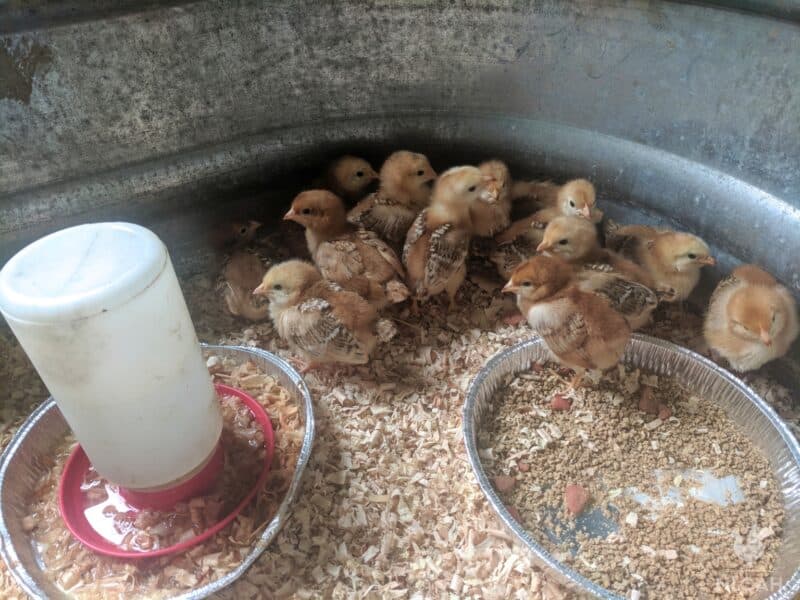
Chick Health Reviews and Buying Tips
Breeding Facility Grading
Regardless of where you choose to purchase chicks, do your due diligence to garner as much knowledge as you can about the cleanliness of the breeding facilities.
Signs that chicks or older birds come from a breeding operation that may not be clean or is at least overcrowded include: untreated wounds, bloody pecked spots, missing feathers, and a vent caked with feces.
Physical Characteristics of Healthy Chicks
1. Eyes
- Clear and Bright
- No excessive blinking
- No swollen or bright red patches on or around the eyes
- No discharge stemming from the eyes.
- No drooping of or around the eyes.
2. Nostrils
- No discharge or fluid of any type draining from the nostrils.
- Nostrils are not caked with any dry discharge.
3. Feet
- The bottom of the chick’s feet should not show any signs of an infection, open wounds, acne-type bumps, or frostbite.
- Feet should not be swollen.
- The nails on the chick’s feet should be straight and be positioned laying back from the toes and neither crooked, spiraled, or just generally too long.
4. Legs
- The chick’s legs should be free from any wounds.
- There should be no odd coloring on the legs.
- The scales on the legs of the bird should be smooth (not bumpy), and the plates flat.
5. Feathers
- The feathers on the chick or older bird should be flat, dry, and smooth – not fluffy in texture.
- Bald spots where feathers should be can be indicative of poor health or dirty breeding conditions.
- If bald spots exist around the chick’s vent, the bird could be struggling with scours (diarrhea) or a parasite infestation.
6. Beak
- The top and bottom of the beak should fit together and be of matching size – no “overbite.”
- The beak should show no signs or chips or be bent in nature.
- The chicks’ vent should open and close fully and evenly.
7. Sounds
Listen intently to each chick for sounds of “rattling,” congestion, wheezing, coughing or sneezing. This will be difficult in a crowded store or large local hatchery with a lot of noisy chicks around, but can be very much worth the effort.
A chick sick with a contagious illness could wipe out an entire flock in just days.
Many farm supply stores do not allow customers to handle the chicks before purchase.
If this is the case at a store you visit, politely but firmly insist the store worker hold each chick up to you ear – even outside of the chick days “cage” area, so you can listen to it breathe, before agreeing to add it to your purchase box.
8. Stature
- The chick should be able to walk around without any signs of a limp.
- Make sure the chick can hold its head up straight, and that it does not droop to either side.
- Watch the chick for a few moments to make certain it is not repeatedly shaking its head.
- Watch the body of the chick as it stands or walks to make sure it is not twitching.
Take note of the smell when standing near the chick habitats. Even if the top of the bedding looks fresh and clean, it was likely simply poured on top of soiled bedding or a tub that was not cleaned after the nasty bedding was dumped out. This smell happens more quickly with ducklings than chicks.
Healthy chicks should be full of energy and moving about in their tank doing a lot of chirping. A sick chick most often will stand alone, as far away from the other birds as possible, and keep its eyes largely closed.
It can be difficult not to feel sorry for a sick or injured chick and be tempted to take it home and try to help it.
While such efforts could be worthwhile, the bird could spread the illness to your other current birds and contaminate the coop in the process – just as it may have done with the livestock tank mates at the store, hatchery, or small-scale breeder.
You could place any sick or injured chicks in quarantine and try to save them, but even if your efforts do not lead to heartbreak, the chicken could end up as merely a homesteading pet and not an egg producer or meat bird.
Keeping Chicks Healthy Once You Get Them Home
No matter where you purchase the chicks or how many are being taken home, you will need proper equipment to keep them healthy.
Chicken heat lamps are typically sold at all agriculture supply stores, along with chick starter feed. It is best to either use just the red heat lamps for the safety of the birds.
If a chick has a small wound you did not detect or becomes pecked at by other birds because feed becomes attached to its feathers, the blood marks left behind where feathers were will attract more pecking – sometimes evolving into a shark attack-style feeding spree.
Chickens are meat eaters and can be drawn to the sight of blood. By using only red heat lamps, blood peck marks can be hidden from view and deter any pecking by the brooder mates.
A thermometer, preferably one with a humidity gauge, should be kept in the brooder with the day old chicks to ensure they are being kept in a 95 F degree (35 C) environment.
If the brooder becomes too hot or too cold, the health of the chicks can be drastically impacted – just as it will if the brooder becomes too damp.
The temperature in the brooder should be reduced by only five degrees per week until the temperature inside the brooder and that of the environment in which they will live, is roughly the same.
To keep the chicks healthy, they must be able to move away from the intense heat at will. The food and waterer should be kept out of direct contact with the heat lamps to prevent the water from becoming too hot, the food becoming moist, or any plastic food or water containers from melting.
The heat lamp should be angled so they are not pointed directly down at the bedding and creating a fire hazard. Many chicks die each year from brooder fires.
Any boredom busters placed in the brooder must also be kept out of direct contact with the brooder light to deter fire, and also to prevent any metal they are made of from getting so hot they burn the feet of the birds.
Before introducing even seemingly healthy chicks from any type of supplier in with other brooder or coop members, they should be quarantined for 3 to 7 days to help ensure they are indeed pest and disease-free.
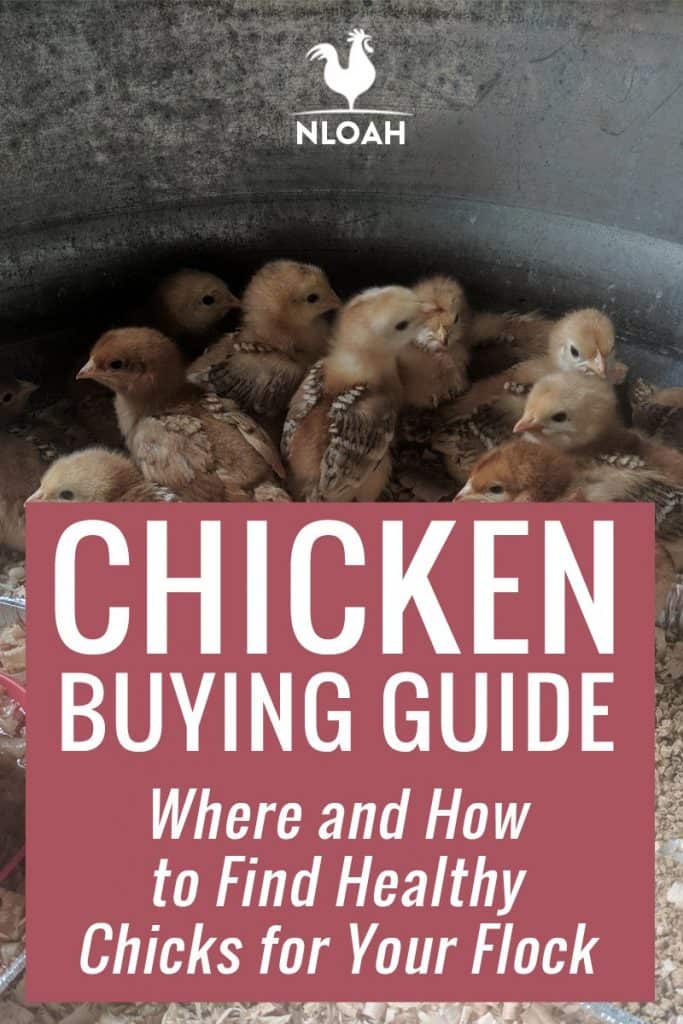

Tara lives on a 56 acres farm in the Appalachian Mountains, where she faces homesteading and farming challenges every single day, raising chickens, goats, horses, and tons of vegetables. She’s an expert in all sorts of homesteading skills such as hide tanning, doll making, tree tapping, and many more.
